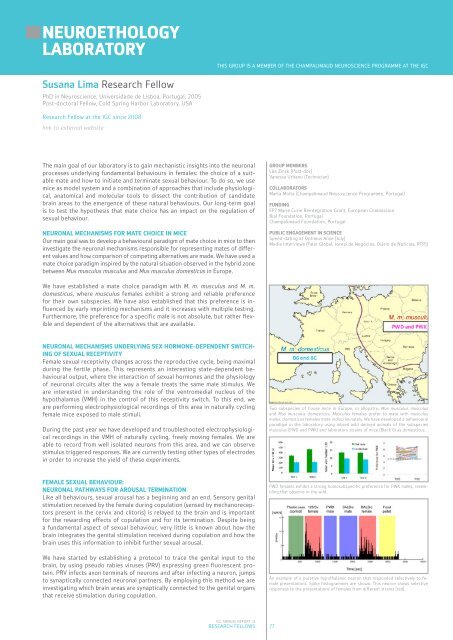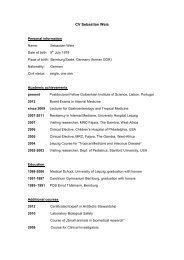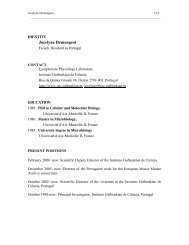organisation - the Instituto Gulbenkian de Ciência
organisation - the Instituto Gulbenkian de Ciência
organisation - the Instituto Gulbenkian de Ciência
- No tags were found...
Create successful ePaper yourself
Turn your PDF publications into a flip-book with our unique Google optimized e-Paper software.
NEUROETHOLOGY<br />
LABORATORY<br />
THIS GROUP IS A MEMBER OF THE CHAMPALIMAUD NEUROSCIENCE PROGRAMME AT THE IGC<br />
Susana Lima Research Fellow<br />
PhD in Neuroscience, Universida<strong>de</strong> <strong>de</strong> Lisboa, Portugal, 2005<br />
Post-doctoral Fellow, Cold Spring Harbor Laboratory, USA<br />
Research Fellow at <strong>the</strong> IGC since 2008<br />
link to external website<br />
The main goal of our laboratory is to gain mechanistic insights into <strong>the</strong> neuronal<br />
processes un<strong>de</strong>rlying fundamental behaviours in females: <strong>the</strong> choice of a suitable<br />
mate and how to initiate and terminate sexual behaviour. To do so, we use<br />
mice as mo<strong>de</strong>l system and a combination of approaches that inclu<strong>de</strong> physiological,<br />
anatomical and molecular tools to dissect <strong>the</strong> contribution of candidate<br />
brain areas to <strong>the</strong> emergence of <strong>the</strong>se natural behaviours. Our long-term goal<br />
is to test <strong>the</strong> hypo<strong>the</strong>sis that mate choice has an impact on <strong>the</strong> regulation of<br />
sexual behaviour.<br />
NEURONAL MECHANISMS FOR MATE CHOICE IN MICE<br />
Our main goal was to <strong>de</strong>velop a behavioural paradigm of mate choice in mice to <strong>the</strong>n<br />
investigate <strong>the</strong> neuronal mechanisms responsible for representing mates of different<br />
values and how comparison of competing alternatives are ma<strong>de</strong>. We have used a<br />
mate choice paradigm inspired by <strong>the</strong> natural situation observed in <strong>the</strong> hybrid zone<br />
between Mus musculus musculus and Mus musculus domesticus in Europe.<br />
GROUP MEMBERS<br />
Léa Zinck (Post-doc)<br />
Vanessa Urbano (Technician)<br />
COLLABORATORS<br />
Marta Moita (Champalimaud Neuroscience Programme, Portugal)<br />
FUNDING<br />
FP7 Marie Curie Reintegration Grant, European Commission<br />
Bial Foundation, Portugal<br />
Champalimaud Foundation, Portugal<br />
PUBLIC ENGAGEMENT IN SCIENCE<br />
Speed-dating at Optimus Alive (July)<br />
Media Interviews (Falar Global, Jornal <strong>de</strong> Negócios, Diário <strong>de</strong> Notícias, RTP1)<br />
We have established a mate choice paradigm with M. m. musculus and M. m.<br />
domesticus, where musculus females exhibit a strong and reliable preference<br />
for <strong>the</strong>ir own subspecies. We have also established that this preference is influenced<br />
by early imprinting mechanisms and it increases with multiple testing.<br />
Fur<strong>the</strong>rmore, <strong>the</strong> preference for a specific male is not absolute, but ra<strong>the</strong>r flexible<br />
and <strong>de</strong>pen<strong>de</strong>nt of <strong>the</strong> alternatives that are available.<br />
NEURONAL MECHANISMS UNDERLYING SEX HORMONE-DEPENDENT SWITCH-<br />
ING OF SEXUAL RECEPTIVITY<br />
Female sexual receptivity changes across <strong>the</strong> reproductive cycle, being maximal<br />
during <strong>the</strong> fertile phase. This represents an interesting state-<strong>de</strong>pen<strong>de</strong>nt behavioural<br />
output, where <strong>the</strong> interaction of sexual hormones and <strong>the</strong> physiology<br />
of neuronal circuits alter <strong>the</strong> way a female treats <strong>the</strong> same male stimulus. We<br />
are interested in un<strong>de</strong>rstanding <strong>the</strong> role of <strong>the</strong> ventromedial nucleus of <strong>the</strong><br />
hypothalamus (VMH) in <strong>the</strong> control of this receptivity switch. To this end, we<br />
are performing electrophysiological recordings of this area in naturally cycling<br />
female mice exposed to male stimuli.<br />
During <strong>the</strong> past year we have <strong>de</strong>veloped and troubleshooted electrophysiological<br />
recordings in <strong>the</strong> VMH of naturally cycling, freely moving females. We are<br />
able to record from well isolated neurons from this area, and we can observe<br />
stimulus triggered responses. We are currently testing o<strong>the</strong>r types of electro<strong>de</strong>s<br />
in or<strong>de</strong>r to increase <strong>the</strong> yield of <strong>the</strong>se experiments.<br />
Two subspecies of house mice in Europe, in allopatry: Mus musculus musculus<br />
and Mus musculus domesticus. Musculus females prefer to mate with musculus<br />
males, domesticus females mate indiscriminately. We have <strong>de</strong>veloped a behavioural<br />
paradigm in <strong>the</strong> laboratory using inbred wild <strong>de</strong>rived animals of <strong>the</strong> subspecies<br />
musculus (PWD and PWK) and laboratory strains of mice (Black 6) as domesticus.<br />
FEMALE SEXUAL BEHAVIOUR:<br />
NEURONAL PATHWAYS FOR AROUSAL TERMINATION<br />
Like all behaviours, sexual arousal has a beginning and an end. Sensory genital<br />
stimulation received by <strong>the</strong> female during copulation (sensed by mechanoreceptors<br />
present in <strong>the</strong> cervix and clitoris) is relayed to <strong>the</strong> brain and is important<br />
for <strong>the</strong> rewarding effects of copulation and for its termination. Despite being<br />
a fundamental aspect of sexual behaviour, very little is known about how <strong>the</strong><br />
brain integrates <strong>the</strong> genital stimulation received during copulation and how <strong>the</strong><br />
brain uses this information to inhibit fur<strong>the</strong>r sexual arousal.<br />
We have started by establishing a protocol to trace <strong>the</strong> genital input to <strong>the</strong><br />
brain, by using pseudo rabies viruses (PRV) expressing green fluorescent protein.<br />
PRV infects axon terminals of neurons and after infecting a neuron, jumps<br />
to synaptically connected neuronal partners. By employing this method we are<br />
investigating which brain areas are synaptically connected to <strong>the</strong> genital organs<br />
that receive stimulation during copulation.<br />
PWD females exhibit a strong homosubspecific preference for PWK males, resembling<br />
that observe in <strong>the</strong> wild.<br />
An example of a putative hypothalamic neuron that respon<strong>de</strong>d selectively to female<br />
presentations. Spike histogrammes are shown. This neuron shows selective<br />
responses to <strong>the</strong> presentations of females from different strains (red).<br />
IGC ANNUAL REPORT ‘11<br />
RESEARCH FELLOWS<br />
77






